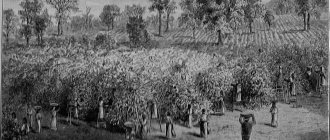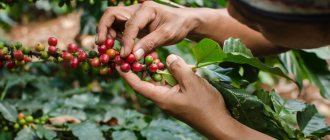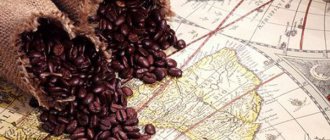Coffee is an important part of the Guatemalan economy. The coffee industry began to develop in the 1850s, and until the beginning of the 21st century, Guatemala was the main producer in Central America, until Honduras took over in 2011. Today Guatemala is only the 10th largest coffee producer in the world, half of all exports go to the United States.
Organoleptic properties. The aroma of Guatemalan coffee has tones of citrus, fruit, and spice. The beans are distinguished by a soft chocolate taste with a distinct sourness, notes of caramel and creamy toffee; they are perfect for blending with other varieties.
Alpine specimens are distinguished by berry and fruit tones, ranging from green apple to citrus.
Although the country does not rank among the top 3 world leaders in the industry, Guatemalan coffee is considered an example of the ideal combination of full body, strength, softness, delicate acidity and complex flavor profile.
History with geography
Guatemala's coffee industry employs a third of adults. The country consistently ranks in the top ten in global exports. Where did the history of Guatemalan coffee begin?
The Jesuit monks, who brought the word of God to the Guatemalan aborigines, also brought coffee seedlings. This happened in the 18th century. It is difficult to say what they hoped for - the climate in the country was not very suitable for coffee production due to the abundance of direct sunlight, which simply burned the weak trees. For about 100 years, coffee plantings eked out a modest existence.
In the 19th century, the country's government did everything possible to draw attention to the prospects of coffee. European settlers were given land practically for nothing.
The vicissitudes of the climate and direct sunlight were overcome by a simple solution - coffee seedlings were planted in the shade of local spreading trees. The result of the efforts was the widespread distribution of coffee plantings. According to the most conservative estimates, there are about 800-850 million coffee trees growing here.
Guatemala takes the coffee industry seriously, strictly controlling the quality of the exported product. Therefore, the grains of each harvest have a stable quality, which is highly valued on world markets.
Historical reference
In the 18th century, explorers brought coffee seedlings to this country (where did the first coffee tree appear?). The event was very shaky as environmental conditions were not conducive to tree development. Bright, scorching sun, high temperature - the plantings quickly dried out. Despite this, for a century the local population was gradually engaged in cultivating a small number of crops.
In the 19th century, the Guatemalan government relied on the coffee industry and did its best to involve the population in this process. Everyone was given land to build plantations for almost nothing (read about plantation coffee). And it paid off.
A little trick played a role. Coffee seedlings were planted next to a large tree, the branches of which protected the shoots from the rays of the sun.
All this has led to the fact that now about 30% of the population works in this area. And according to analysts, several hundred million coffee trees grow in Guatemala.
Features of coffee from Guatemala
Almost all Guatemalan coffee is Arabica of various types, with a predominance of Typica. Typica was once very common in Central and South America, but in most countries its plantings were destroyed by an epidemic of coffee rust.
Old varieties with their stable and recognizable taste are one of the secrets of the success of Guatemalan coffee.
Growing
The landscape of Guatemala consists of highlands, plateaus and foothills. The higher the plantation is located above sea level, the higher the quality of the grain. In the highlands, the coffee bean grows strong, dense, with a high content of aroma and taste. Coffee that grows closer to the coast matures under the influence of sea breezes. Coastal plantations are at lower altitudes, from 750 to 1050 m above sea level.
The best varieties are grown in the region that is located around the country's capital, Antigua. The plantations here are located on highly elevated volcanic slopes, on the fertile soils of an extinct volcano. The average altitude of plantations is from 1350 to 1800 m.
All coffee is grown in a natural, natural way, without the use of growth and ripening accelerators.
Taste
Because many of the country's peaks are former volcanoes, the soil here is rich in volcanic ash and organic matter. This is why all Guatemalan coffee has a smoky note. The most intense bouquets and aromas come from elite durum varieties that grow at high altitudes.
The lower the slopes, the softer and more delicate the taste of the grains. Coffee from the coast has a delicate bouquet with fruity sourness and floral aromas. It is not as strong as high-mountain varieties, but its taste cannot be called ordinary. Perhaps the highlight is that savory, smoky note that is the hallmark of Guatemalan coffee.
Classification by height of growth
Guatemala, like other Central American countries, uses a classification of coffee based on the altitude of its growth.
Prime : grows at an altitude of 750-900 m
Extra Prime : grows at an altitude of 900-1050 m
Semi Hard Bean : grows at an altitude of 1050-1220 m
Hard Bean (HB) : grows at an altitude of 1220-1300 m
Strictly Hard Bean (SHB) : grows at altitudes above 1300 m
Antigua and other varieties
What varieties can be found on the shelves of our stores and which ones are worth our attention?
Guatemala Antigua
An elite variety of coffee grown in the highest mountains of the country. It was named after the geographical region. The finished drink is dense and rich, the taste is multifaceted and complex. The smoky aroma is noticeable in it. The coffee opens up with every sip; notes of chocolate, cocoa, and sometimes prunes are discernible. The range ends with light fruity nuances.
The variety is perfect for cooking in a cezve, for brewing in a pour-over, or simply in a cup.
Guatemala Cabano
It may cost more than Antigua due to the capricious climate, which results in additional production costs. The variety has a rich flavor bouquet, with light nutty notes, nuances of chocolate, cocoa and floral notes. Its aroma is subtler than that of Antigua. The Cabano variety is well suited for preparing coffee using alternative methods: in a Chemex or pour over.
Maragogyp
Imported from Brazil, famous for its large grains. It is strongly reminiscent of Brazilian coffee, has a well-defined bitterness and sharp sour notes. Can be prepared in a drip coffee maker or Turkish coffee maker.
Guatemalan coffee
The variety is called exactly that - Guatemala. It deserves the attention of those who love unusual flavor accents. The coffee has a spicy pungency and a bright aroma with notes of chocolate and peanuts, and a distinct smoky taste. Like the best varieties, the bouquet reveals gradually, from a thick chocolate-nut to a warm bready taste. Ideal for Aeropress, pour-over, can be cooked in a cezve on sand or in a regular Turkish pot over low heat.
Cames
One of the plantation monovarietals. The finished drink is dense, with a thick, rich taste. The aroma is fruity and nutty, with a citrusy refreshing sourness. Great for French press and cup brewing, and fine grind for cezve.
Taste characteristics
Guatemalan coffee has a sweet taste with a dense body and a chocolate aroma. Many varieties have a bittersweet cocoa flavor or a sweet milky flavor. In addition to these shades, coffee can have nutty and caramel notes. Beans grown at high altitudes, such as in Huehuetenango, are characterized by bright berry or citrus flavors.
Where to buy Guatemalan coffee?
Residents of large cities and capitals can find Guatemalan coffee in specialized coffee shops. For those who want to save time, we can recommend turning to online stores. You can find all the main varieties of Guatemalan coffee and even rarer plantation varieties.
The price of Guatemala coffee varies depending on the variety, producer and year. On average, 100 g of freshly roasted coffee costs from 200 to 350 rubles.
If you order coffee from an online store, then take freshly roasted, but not ground, beans so that they retain their taste and aroma as much as possible during the delivery process.
Geography of growth
Guatemala has one of the most diverse climates for coffee production in the world. The plantations are located in seven regions, the most popular of which are Antigua, Huehuetenango and Atitlan. Each region has unique coffee flavor profiles, natural conditions, microclimates, soils and growing altitudes.
Antigua coffee is grown on the slopes of volcanoes in arid and sunny areas. It is the most famous growing area and is also home to the oldest coffee plantations in the country, some of which have been passed down from generation to generation in the same family. Beans from this region are characterized by a dense body and sweetness with low to medium acidity. Chocolate taste and fruity tones are the hallmarks of beans from Antigua.
The Huehuetenango region near the Mexican border has the highest altitudes: up to 2,000 meters. The coffee is dominated by bright sourness with fruity tones. Varieties from this region can be compared to coffee from Ethiopia, only Guatemalan has a denser body. Our Sierra Morena coffee is produced here.
Coffee trees in Atitlán also grow in volcanic soils near the lake of the same name. Water from this reservoir is used for grain processing. The area here is windier and wetter, and the coffee is dominated by nutty and chocolate notes.
Other regions include the Fraijanes Plateau, surrounding Guatemala City (the country's capital); tropical forests of Coban in the north of the country with a humid climate; San Marcos Volcano, the warmest and wettest region; arid Oriente region with volcanic soil.
Since the country abounds in rainfall, the main method of processing there is washed. High humidity levels prevent farmers from processing grains naturally or dryly.
Manufacturers also prefer washed processing, as they believe that it better highlights the inherent acidity of Guatemalan grains than natural processing.
Coffee culture
Unfortunately, the country has a high level of poverty, so coffee consumption is not common there, especially in rural areas. More than 50% of the population lives below the poverty line. Almost all the coffee that meets export standards is sent to other countries, leaving the country's residents to make do with what's left or buy instant coffee.
The situation in the capital is slightly better. Gradually, the culture of coffee consumption comes to Guatemala and coffee shops open. The coffee shops use imported equipment and hold cuppings and master classes to help people better understand the coffee they drink. The country's urban coffee culture is gradually becoming the most revolutionary and forward-looking in the world, but development is slower than it could be due to poverty.
Guatemala is known for its volcanoes, lakes and coffee. With such varying microclimates and growing conditions, the country has a large number of varieties with unique flavor profiles. Despite the fact that there are problems in the coffee industry, production is growing and developing, which opens up opportunities for growing coffee, and coffee itself is consistently rated highly by experts and drink lovers.











